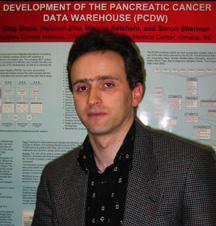 If you ask Oleg Shats what it takes to manage huge amounts of data, the answer might surprise you.
If you ask Oleg Shats what it takes to manage huge amounts of data, the answer might surprise you.
“Common sense,” he says from his office at the Scott Technology Center, where he serves as information systems manager for the Bioinformatics and Molecular Modeling Facility at the Eppley Institute.
Shats’ common sense approach — rooted in his homeland of St. Petersburg, Russia — enables him to apply computer technology to manage, organize, interpret and understand massive amounts of biological information. It recently led to the successful development of the Pancreatic Cancer Collaborative Registry.
For his outstanding performance and service to the Bioinformatics Shared Resources at the Eppley Cancer Center, he has received this month’s Chancellor’s Gold ‘U’ Award.
Shats, who earned a master’s degree in engineering from St. Petersburg State Technical University, has long held an interest in computers. Before coming to the United States and joining UNMC in 1995, he was associate director of an information technology department in the State Institute of Power Industry in St. Petersburg, where he wrote software applications and managed the institute’s network.
|
|
And what does he find challenging about his work? “To stay current in the rapidly changing IT industry,” Shats said. “Trying to explain to users what we would like to create is also challenging. Usually, we speak different languages, and I’m not talking about Russian and English.”
With each project, Shats and his programming team talk to perspective users to gather system requirements. “In 90 percent of cases the users have a very general idea about what they would like the software to do for them, so we put ourselves in the user’s shoes and try to follow our imagination and common sense. We look at the data users have and see how we can use this data to extract meaningful information from it. Then we develop a prototype and demonstrate it to users so it’s easier to realize the possibilities of the system. We try to design our software as simple as possible. If you make something too complicated no one will use it.”
His nominator praised his work on the Pancreatic Cancer Collaborative Registry, which Shats said took four years to create and “there are still a lot of things to be done.”
“This Web-based registry is aimed at collecting, in a standardized format, information on pancreatic cancer patients,” his nominator said. “The development of this registry has put the Bioinformatics Shared Resources at UNMC on ‘the map.’ Because of the quality and performance of these bioinformatics tools and his vision for success, several leading cancer researchers and institutions have expressed an interest in extending this new technology for other cancer types.”
That’s what makes the work worthwhile, Shats said. “It’s satisfying to see our systems being used.” There are more than 10 centers involved in the registry, including New York Medical College, Johns Hopkins Hospital, Evanston Northwestern University Healthcare, University of Pittsburgh, Mayo Clinic and the National Cancer Institute.
In addition to the Pancreatic Cancer Registry, which uniformly collects critical information and biological samples to help develop preventive and treatment strategies, Shats is working to develop similar registries for breast and lung cancers.
Shats’ knowledge and skills have been instrumental in several projects aimed at developing and supporting an information technology infrastructure for the Nebraska Informatics Center for the Life Sciences, where he has facilitated the intercampus (UNMC, University of Nebraska-Lincoln, University of Nebraska at Omaha and Creighton University) efforts in the bioinformatics, computational chemistry and computational biology.
When he’s not spending time with his wife, Aelita, and their 11-year-old twin boys, he enjoys reading and working on his computer.
Shats’ “openness and willingness to help others accomplish special tasks promotes an atmosphere conducive for learning,” his nominator said. “The catch phrase that can be heard around the office several times a day is ‘check with Oleg.’ His accommodating attitude always makes ‘checking with Oleg’ an easy task.”